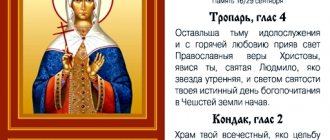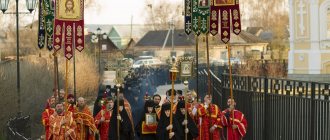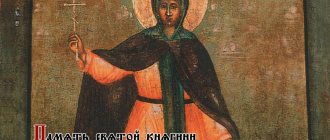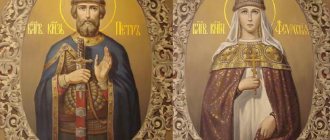| Grand Duchess Elizaveta Feodorovna |
Elisaveta Feodorovna
(1864 - 1918), Grand Duchess, Venerable Martyr Memory July 5, September 28 - the discovery of relics in 1918 [1], January 17 - the memory of the transfer of relics to Jerusalem in 1921 (ROCOR [2]), January 25 (Grech . [3]), in the Councils of Ekaterinburg, Moscow and St. Petersburg saints and in the Council of New Martyrs and Confessors of the Russian Church
Born on October 20, 1864 in the Protestant family of the Grand Duke of Hesse-Darmstadt Ludwig IV and Princess Alice, daughter of Queen Victoria of England. Ella was the second child in the family. The children were brought up in the traditions of old England. Their life passed according to the rules strictly established by their mother. Children's clothing and food were very basic. The three eldest daughters did the housework themselves: they cleaned the rooms, beds, and lit the fireplace. Subsequently, Elisaveta Feodorovna said: “They taught me everything in the house.”
In 1884, she married Grand Duke Sergei Alexandrovich, brother of Emperor Alexander III of Russia.
Seeing the deep faith of her husband, the princess with all her heart sought the answer to the question - which religion is true? She prayed fervently and asked the Lord to reveal His will to her. On April 13, 1891, on Lazarus Saturday, the rite of acceptance into the Orthodox Church was performed over Elisaveta Feodorovna. In the same year, Grand Duke Sergei Alexandrovich was appointed Governor-General of Moscow.
Visiting churches, hospitals, orphanages, nursing homes and prisons, the princess saw a lot of suffering. And everywhere she tried to do something to alleviate them. After the start of the Russian-Japanese War in 1904, Elisaveta Feodorovna helped the front and Russian soldiers in many ways. She worked until she was completely exhausted.
| Grand Duchess Elizaveta Feodorovna and Grand Duke Sergei Alexandrovich |
On February 4, 1905, Prince Sergei Alexandrovich died from a bomb explosion by a revolutionary terrorist.
Elisaveta Feodorovna rushed to the scene of the explosion and saw a picture that surpassed human imagination in its horror. Silently, without screaming or tears, kneeling in the snow, she began to collect and place on a stretcher the body parts of her beloved husband, who had been alive just a few minutes ago. In the hour of difficult trials, Elisaveta Feodorovna asked for help and consolation from God. The next day she received Holy Communion in the church of the Chudov Monastery, where her husband’s coffin stood. On the third day after the death of her husband, Elisaveta Feodorovna went to prison to see the killer. She didn't hate him. The Grand Duchess wanted him to repent of his terrible crime and pray to the Lord for forgiveness. She even submitted a petition to the Emperor to pardon the killer.
Elisaveta Feodorovna decided to devote her life to the Lord through serving people and create a monastery of work, mercy and prayer in Moscow. She bought a plot of land with four houses and a large garden on Bolshaya Ordynka Street. In the monastery, which was named Marfo-Mariinskaya in honor of the holy sisters Martha and Mary, two churches were created - Marfo-Mariinsky and Pokrovsky, a hospital, which was later considered the best in Moscow, and a pharmacy where medicines were dispensed to the poor for free, an orphanage and a school . Outside the walls of the monastery, a house-hospital was set up for women suffering from tuberculosis.
On February 10, 1909, the monastery began its activities. On April 9, 1910, during the all-night vigil, Bishop Trifon of Dmitrov (Turkestan) (+1934), according to the rite developed by the Holy Synod, consecrated the nuns to the title of sisters of the cross of love and mercy. The sisters took a vow, following the example of the nuns, to spend a virgin life in work and prayer. The next day, during the Divine Liturgy, Saint Vladimir, Metropolitan of Moscow and Kolomna, placed eight-pointed cypress crosses on the sisters, and elevated Elisaveta Feodorovna to the rank of abbess of the monastery. The princess said that day: “I am leaving the brilliant world ... but together with all of you I am ascending into a greater world - the world of the poor and suffering.”
| Grand Duchess Elizaveta Feodorovna |
At the Martha and Mary Convent, Princess Elisaveta Feodorovna led an ascetic life: she slept on a wooden bed without a mattress, often for no more than three hours;
she ate food very moderately and strictly observed fasts; at midnight she got up for prayer, and then went around all the hospital wards, often remaining at the bedside of a seriously ill patient until dawn. She told the sisters of the monastery: “Isn’t it scary that out of false humanity we are trying to lull such sufferers to sleep with the hope of their imaginary recovery. We would do them a better service if we prepared them in advance for the Christian transition into eternity.” Without the blessing of the monastery’s confessor, Archpriest Mitrofan of Srebryansky, and without the advice of the elders of Optina Hermitage and other monasteries, she did nothing. For complete obedience to the elder, she received inner consolation from God and gained peace in her soul. Since the beginning of the First World War, the princess organized assistance to the front. Under her leadership, ambulance trains were formed, warehouses for medicines and equipment were set up, and camp churches were sent to the front. The abdication of Emperor Nicholas II from the throne was a big blow for Elizabeth Feodorovna. Her soul was shocked, she could not speak without tears. Elisaveta Feodorovna saw into what abyss Russia was flying, and she wept bitterly for the Russian people, for her dear royal family.
Her letters from that time contain the following words:
“I felt such deep pity for Russia and its children, who currently do not know what they are doing. Isn't it a sick child whom we love a hundred times more during his illness than when he is cheerful and healthy? I would like to bear his suffering, to help him. Holy Russia cannot perish. But Great Russia, alas, no longer exists. We... must direct our thoughts to the Kingdom of Heaven... and say with humility: “Thy will be done.”
| Venerable Martyr Elisaveta Feodorovna, icon |
Elisaveta Feodorovna was arrested on the third day of Easter 1918, Bright Tuesday.
On that day, Saint Tikhon served a prayer service at the monastery. The monastery sisters Varvara (Yakovleva) and Ekaterina Yanysheva were allowed to go with her. They were brought to the Siberian city of Alapaevsk on May 20, 1918. Grand Duke Sergei Mikhailovich and his secretary Feodor Mikhailovich Remez, Grand Dukes John, Konstantin and Igor Konstantinovich and Prince Vladimir Paley were also brought here. Elisaveta Feodorovna's companions were sent to Yekaterinburg and released there. But sister Varvara ensured that she was left with the Grand Duchess.
On July 18, 1918, the prisoners were taken at night in the direction of the village of Sinyachikha. Outside the city, in an abandoned mine, a bloody crime took place. With loud curses, beating the martyrs with rifle butts, the executioners began to throw them into the mine. Princess Elizabeth was the first to be pushed down. She crossed herself and prayed loudly: “Lord, forgive them, they don’t know what they’re doing!”
Elisaveta Feodorovna and Prince John fell not to the bottom of the mine, but to a ledge located at a depth of 15 meters. Severely wounded, she tore off part of the cloth from her apostle and bandaged Prince John to ease his suffering. A peasant who happened to be near the mine heard the Cherubic Song sounding in the depths of the mine - the martyrs were singing.
| Killing prmts. Elizabeth and those with her. 6th mark of the icon of the Council of New Martyrs and Confessors of Russia from the Cathedral of Christ the Savior. |
Reverence
A few months later, the army of Admiral Alexander Vasilyevich Kolchak occupied Yekaterinburg, and the bodies of the martyrs were removed from the mine. The venerable martyrs Elizabeth and Varvara and Grand Duke John had their fingers folded for the sign of the cross. During the retreat of the White Army, the coffins with the relics of the holy martyrs were delivered to Jerusalem in 1920.
At the Council of Bishops on November 14, 1981, the Russian Orthodox Church Outside of Russia glorified the holy Grand Duchess as a venerable martyr among the holy new martyrs of Russia [4]. In the modern official calendar of the ROCOR, on July 5, the memory of “Reverend” is listed: led. Princess Elizabeth, nun Varvara and others like them. princes: John, Igor, Constantine, Sergius, Vladimir and martyrs. Theodora" [5]. All named persons are also included in the calendar of the Constantinople Orthodox Church [6].
On May 1 and 2, 1982, on the feast of the Holy Myrrh-Bearing Women, the relics of the Venerable Martyrs Elizabeth Feodorovna and Barbara were transferred from the crypt in the Church of Equal-to-the-Apostles Mary Magdalene at the foot of the Mount of Olives. At the beginning of the 21st century, the relics of the saints rest in this temple; two white marble tombs with icons of saints are located near the altar.
In the spring of 1992, Grand Duchess Elisaveta Feodorovna and nun Varvara were also glorified by the Council of Bishops of the Moscow Patriarchate. In 1995, at the site of the death of the holy martyrs, the Alapaevsky Monastery was founded in the name of the Russian New Martyrs.
On the icon of the Council of New Martyrs and Confessors, painted on the occasion of their common glorification in 2000, the sixth mark depicts the murder of the Venerable Martyr Elizabeth and others like her - her cell attendant Varvara, Grand Duke Sergei Mikhailovich, Prince Vladimir Paley, Grand Dukes John, Constantine and Igor, as well as their devoted servants.
Time for good deeds. In memory of Grand Duchess Elisaveta Feodorovna Romanova
In Moscow
In memory of the great benefactor Elisaveta Feodorovna Romanova, the Church of the Holy Martyr Elisabeth was built in Moscow in Pokrovsky-Streshnevo.
The temple was consecrated on May 13, 2012, and on August 29 of the same year it was given the status of the Patriarchal Metochion. The rector of the temple is Metropolitan Mark of Ryazan and Mikhailovsky . The ktitor - temple builder and temple keeper - is the Russian scientist and philanthropist Igor Ashurbeyli .
It was no coincidence that the temple in the name of St. Elizabeth appeared on Ivankovskoye Highway. There are many hospitals and medical centers around. Helping the sick and disadvantaged was the main work of Elisaveta Feodorovna's . Her actions were unprecedented in terms of the scale of the funds invested, and most importantly, the real benefits they brought. These acts destroyed many stereotypes and ideas about charity of that time.
Founded by Elisaveta Feodorovna, the Marfo-Mariinsky Convent in Moscow was primarily a medical educational and treatment institution, and only then a monastery. The best doctors and professors from Moscow University taught there. The sisters of mercy who entered the monastery for the first time had the right to voluntarily choose: to stay in the monastery forever or, after serving the required period after training, go out into the world and start a family. Elisaveta Feodorovna herself became the abbess of the monastery without taking monastic vows.
Grand Duchess Elisaveta Feodorovna (53 years old). Photo: wikipedia.org
Thanks to Elisaveta Feodorovna , thousands of lives were saved, thousands of people at a tragic turning point in their destinies regained ground under their feet. In the numerous shelters she founded, the wards were not doomed to eternal dependence, as in other charitable institutions of that time. They were not just provided with shelter and food, they were trained in trades so that children and adults in difficult circumstances could find their own path and be able to provide for themselves. Human life and human dignity were put at the forefront here. The world created by the Grand Duchess was a stronghold, an oasis of humanism in the very center of a collapsing empire.
This woman's courage is impressive. During the bloody time of popular unrest that engulfed almost the entire country, she, having the opportunity to leave, to save herself, remained in Russia, clearly understanding that here she was more needed and that here she was doomed... With one calmly spoken phrase, with one look, she could stop the raging crowd, besieging her Abode.
The Patriarchal Metochion of the Church of the Holy Martyr Elizabeth in Pokrovskoye-Streshnevo supports the sisterhood of mercy, provides assistance to the sick and needy, and brings comfort to those who are being treated or visiting patients in medical institutions of Ivankovskoe Highway.
Near the temple there are two sculptural portraits of St. Elizabeth. Elisaveta Feodorovna is depicted in her two guises - secular and spiritual, in two main periods of her life: the Grand Duchess, wife of Moscow Governor-General Sergei Alexandrovich Romanov, and the Great Mother, abbess of the Marfo-Mariinsky Convent. In the Urals
Igor Ashurbeyli also assisted in the construction of a church in the name of the Holy Martyr Elizabeth in Alapaevsk.
The temple was consecrated in 2022 - the year when the centenary of the death of the Royal Passion-Bearers was celebrated - the family of Nicholas II , killed in Yekaterinburg, and the Alapaevsk martyrs, among whom was the sister of the last Russian empress, the widow of the emperor's uncle Elisaveta Feodorovna Romanova .
In the Christian tradition, the day of the death of a saint is celebrated as a holiday - a celebration of his reunion with the Lord. But the events of July 18, 1918 are not that long ago. The cruelty with which one of the most remarkable women of her century was killed, and with her seven more people - representatives of the Romanov dynasty and their associates, still shakes to the core. The Alapaevsk martyrs were thrown alive into a deep mine and left to die from their wounds, hunger and thirst. In the Holy Land
Heading the Council of the Imperial Orthodox Palestine Society in Israel and managing the Sergius Metochion in Jerusalem, Igor Ashurbeyli continues in the Holy Land the work begun by members of the Russian Imperial House, including Elisaveta Feodorovna Romanova .
Grand Duke Sergei Alexandrovich with his wife Grand Duchess Elizaveta Feodorovna. Photo 1892
Elisaveta Feodorovna became the second Chairman of the IOPS in history, taking this post after the death of the first Chairman, her husband Grand Duke Sergei Alexandrovich .
Igor Ashurbeyli has repeatedly noted that, unlike the crusaders, who conquered Palestine with fire and sword, Russia always came to the Holy Land in peace, carrying out a charitable, cultural and educational mission. The IOPS built churches, hospitals, schools, farmsteads and hospice houses there.
The Sergievskoye Metochion, historically the headquarters of the IOPS, today, like a century ago, serves as the center of the Russian cultural presence in the Holy Land.
The day of the grand opening of the Sergius metochion after restoration was chosen on July 18, 2022 - the day of memory of St. Elizabeth and the day of the discovery of the relics of Sergius of Radonezh. The Unfinished Pilgrimage of Saint Elizabeth
In 2013, Igor Ashurbeyli organized a new pilgrimage route along the Great Sorrowful Posthumous Path of the Holy Martyr Grand Duchess Elizabeth Feodorovna Romanova.
The first pilgrimage was timed to coincide with the 95th anniversary of the death of Elizabeth Feodorovna and the 400th anniversary of the House of Romanov.
Main points of the route:
- Moscow, where Elisaveta Feodorovna lived most of her life, doing charity work, first as the wife of the Moscow Governor-General, and then as the abbess of the Marfo-Mariinsky Convent. In this city she was arrested by the Bolsheviks, from here her path to Calvary began;
- Yekaterinburg is the place of imprisonment and murder of the family of Nicholas II;
- Alapaevsk - the place of imprisonment, murder, as well as the initial burial of Elisaveta Feodorovna Romanova and other Alapaevsk martyrs;
- Beijing is the temporary burial place of Elisaveta Feodorovna; here her remains found refuge after they were taken out of Russia;
- Jerusalem, where now, under the shadow of the Church of St. Mary Magdalene, Equal-to-the-Apostles, rest the relics of St. Elizabeth and her faithful companion St. Venerable Martyr Nun Varvara, who accepted martyrdom together with Elisaveta Feodorovna.
August pilgrims Grand Duke Sergius Alexandrovich, Grand Duchess Elizaveta Feodorovna, Archimandrite Antonin (Kapustin) and other pilgrims at the consecration of the Church of St. Mary Magdalene in Gethsemane. 1888 Photo from the album of Hieromonk Timon
Elisaveta Feodorovna visited Jerusalem Grand Duke Sergei Alexandrovich . Together with her husband, she attended the consecration of the Church of Mary Magdalene, built with funds from the IOPS. According to legend, the young Grand Duchess was so impressed by the paradise of the Gethsemane monastery that she immediately expressed a desire to be buried here.
However, in her Spiritual Testament, written much later, four years before her death, she asked to be buried in Russia. Igor Ashurbeyli , speaking during the Elizabethan Days in Darmstadt in November 2014, at a conference dedicated to the 150th anniversary of the birth of the Grand Duchess, reminded everyone who cherishes the memory of Elizabeth Feodorovna of this, and cited an excerpt from her Spiritual Testament: “Please to bury me in a crypt under the church that I have now built in the name of the Intercession of the Most Holy Theotokos in my possession on Bolshaya Ordynka in Moscow at my Convent of Mercy in the place indicated by me for the abbess of the monastery, lowering my coffin to the very bottom, into the ground... In case If I die abroad or outside of Moscow, I ask you to put it in a coffin, close it completely, transport it to Moscow and bury it (without opening the coffin) where I indicated above.”
– Elizabeth’s lifetime journey was completed on the day when her soul left the Earth and returned to God. Then - on Earth, when she was glorified as a saint by the united Russian Orthodox Church and her heavenly path was completed on Earth, in the World. But I believe that the earthly posthumous journey of Saint Elizabeth, her pilgrimage, which temporarily and forcedly stopped at the monastery of Mary Magdalene in Jerusalem, is not yet completed. May she return with glory to Moscow! Amen! – said Igor Ashurbeyli.
To date, Elisaveta Feodorovna’s last will A piece of her relics was nevertheless returned to her homeland, and now you can venerate her in the Patriarchal Compound Church of the Holy Martyr Elizabeth in Pokrovsky-Streshnevo.
Prayers
Troparion of the Prmc. led book Elizabeth, voice 1
By humility you hid your princely dignity, / the godly Elisaveto, / through the deep service of Martha and Mary, / you honored Christ. / By mercy, patience and love, you chose to honor yourself, / like a sacrifice you have offered yourself to God as a righteous woman, / but we, who honor your virtuous life and suffering, / as We earnestly ask you to be a true mentor:/ Holy Martyr Grand Duchess Elizabeth, // pray to Christ God to save and enlighten our souls.
Kontakion prmts. led book Elizabeth, voice 2
Who tells the story of the greatness of the feat of faith: / in the depths of the earth, as in heaven of lordship, / the passion-bearer Grand Duchess Elizabeth / with the angels rejoicing in psalms and songs / and enduring murder ,/ crying out for the godless tormentors:/ Lord, forgive them this sin,/ They don’t know what they are doing./ Through your prayers, O Christ God, // have mercy and save our souls.









